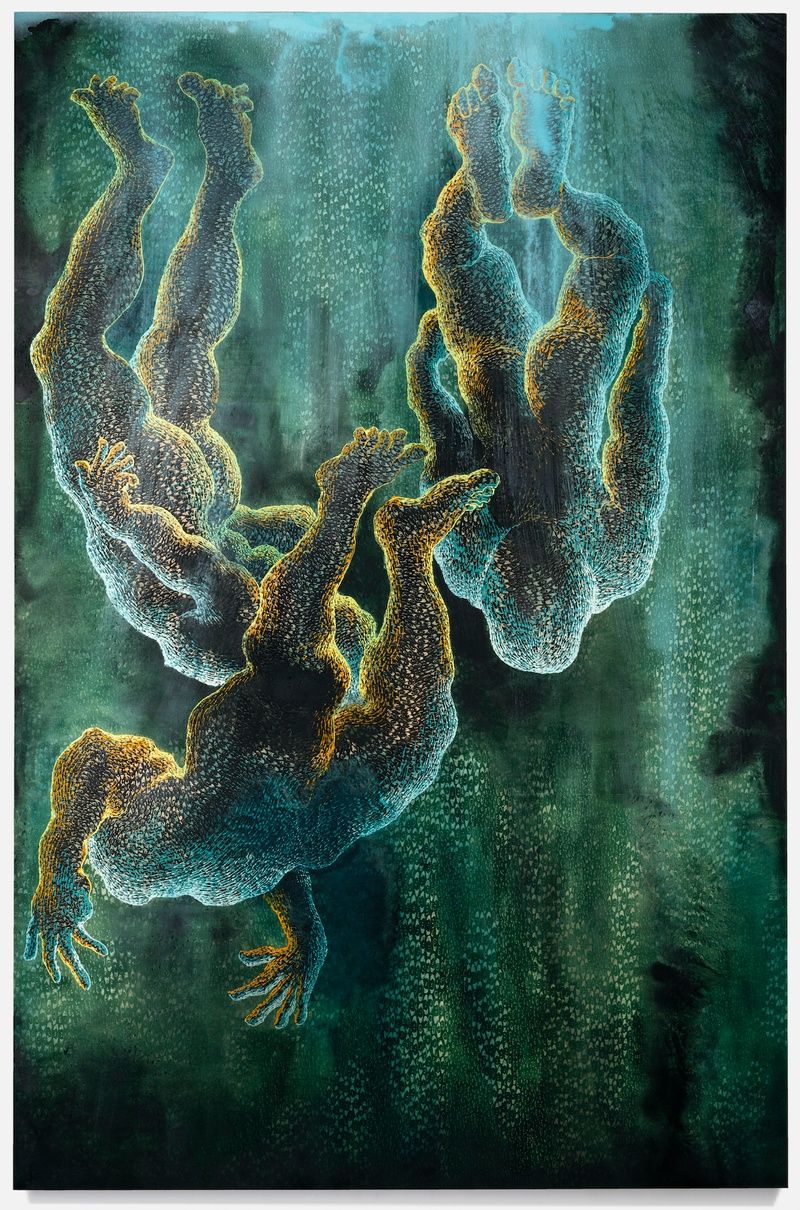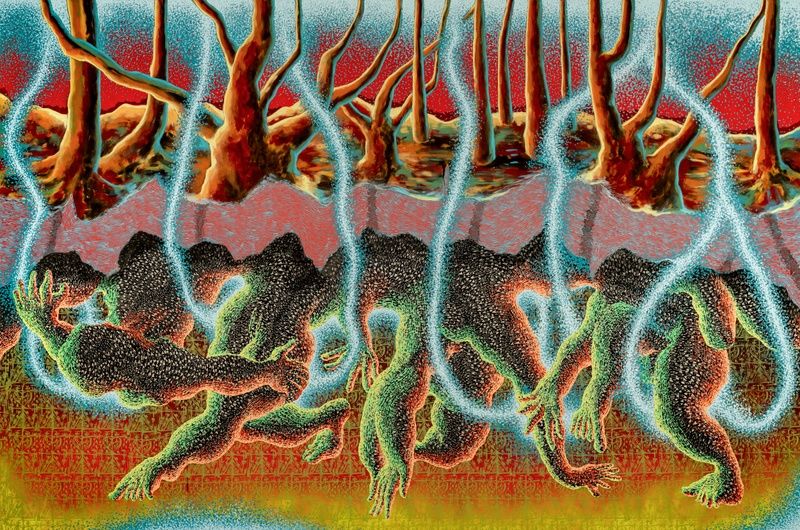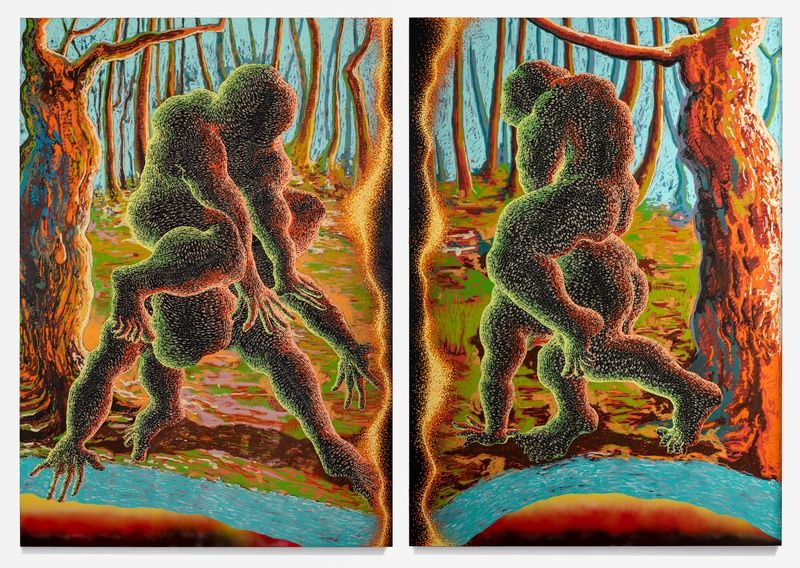James Fuentes Gallery
Didier William
Things Like This Don’t Happen Here
James Fuentes is honored to inaugurate the gallery’s new Los Angeles location with a solo exhibition of new work by Didier William, Things Like This Don’t Happen Here.
Marrying techniques of painting and printmaking with processes of carving and collage, William’s visual terrains are as layered in meaning as they are material. In these works, scales of personal narrative and biography merge and expand across historical timelines and into the realm of mythology. The result is a radical connection to generational memory that gives form to the varying complexities of diasporic identity and makes material its continual transformation. Presenting fourteen new paintings, Things Like This Don’t Happen Here advances William’s ongoing investigation of language, aesthetics, tradition, trauma, and autobiography in a manner that is deeply imaginative, mythological, and metaphysical in perspective.
William’s new works describe underwater seascapes, suspended rock formations, tectonic splits, as well as scenes drawn from a place of memory. These images discard the kind of boundary that arbitrarily designates nation or possession. Instead they transpire at a different border: between heaven and hell, life and death, this life and the next, however we choose to name it. In this way, the ocean connotes the processes and history of immigration across the Caribbean, and at the same time visualizes a body of water as a spatial alternative, “a kind of weightless freedom.” Likewise the cave—of which there are hundreds in the artist’s birthplace of Haiti, both containing and preserving a kind of subterranean archive of the country's past—appears stripped of gravity, forming a pocket of space now in closer conversation with sky than ground. In other works, reimagined scenes from the artist’s childhood transfigure familial memory into mythology. Herein lies the body’s capacity to remember home, to remake space in the present.
The question of space is central to William’s thinking. Over time, formal devices such as the stage, curtains, and shadows have morphed into mountainous and oceanic terrains. In the artist’s newest body of work, this question itself transforms. The very topography of William’s images start to reveal secondary and tertiary domains, so that a new focus resides in moments of intersection between spaces. The image constructs a cross-section through which we observe both above and below; at the same time demarcating the end of the terrain and the beginning of the picture plane of the painting. All at once we are positioned between the representational present, the fleshy stratified earth, and the subterranean afterlife.
A brilliant, charged current runs throughout these manifold spaces, forming a portal between them. In one image, we see what it might look like from within if one of William’s figures were to pass through this electrified channel. In the exhibition title William cites an of-used euphemism. “Things like this don’t happen here” might be uttered when tragedy strikes, or indeed in an instance of remarkable good fortune. It pinpoints a moment of disconnect with something that has just occurred; a sense that the thing in question belongs someplace else. This is a spatial declaration as much as it is one about privilege or identity, connoting an identification and distancing in the very same phrase. William’s work establishes a conduit connecting such disparate elements to one another—an energy source like a bolt of lightning, charged by body rather than sky.
Didier William (b. 1983) is originally from Port-au-prince Haiti. He earned his BFA in painting from The Maryland Institute College of Art and an MFA in Painting and Printmaking from Yale University, School of Art. William is the subject of a career survey currently on view at the Museum of Contemporary Art, North Miami. His work has been exhibited at institutions including the Figge Art Museum, Crystal Bridges Museum of American Art, Bronx Museum of Art, Museum of African Diaspora in San Francisco, The Museum of Latin American Art in Long Beach, and Pennsylvania Academy of Fine Arts, among others. He received the 2022 Louis Comfort Tiffany Foundation Biennial Grant, 2020 Joan Mitchell Foundation Painters & Sculptors grant, and 2018 Rosenthal Family Foundation Award in Art from the American Academy of Arts and Letters. William was an artist in residence at the Marie Walsh Sharpe Art Foundation in Brooklyn, NY and has taught at several institutions including Yale School of Art, Vassar College, Columbia University, UPenn, and SUNY Purchase. He is currently Assistant Professor of Expanded Print at Mason Gross School of the Arts at Rutgers University. William’s work is in the permanent collections of the MOCA North Miami, ICA Miami, Carnegie Museum of Art, de Young Museum, Crystal Bridges Museum of American Art, Figge Art Museum, Minneapolis Institute of Art, and JPMorgan Chase Art Collection, among others. In 2021 James Fuentes Press published the first monograph on the artist’s work, including contributions from Jessica Bell Brown, Erica Moiah James, Jerry Philogene, and Zoé Samuszi. William lives and works in Philadelphia.
James Fuentes Los Angeles occupies a 1920s era commercial building along a lively strip of Melrose Avenue, reenvisioned by internationally recognized architecture studio and design consultancy Leong Leong. The gallery’s 3,700 square-foot interior is organized by a series of 14-foot walls that meet the exposed wood of its bow-truss ceiling. Seismic bracing installed in the 1990s is left to puncture through the gallery walls, amplifying a contrast between old and new. The space continues to a rear parking lot, repurposed into a courtyard for gatherings and installations. In contrast to its busy surroundings, the building’s envelope is treated as a neutral, anonymous form, expressing the character of the original brick pilasters and sawtooth detailing, with glass block and solid metal doors creating an opaque visage from the street. Founded in 2009, Leong Leong works globally and at many scales. They designed the US Pavilion for the 14th Venice Architecture Biennale and have been recognized with awards from The Architectural League of New York, The American Institute of Architects, Architectural Record, Architizer, Dezeen, and The Architect’s Newspaper. The studio has exhibited internationally at the Guggenheim Museum Bilbao, The MAK Center for Art and Architecture, Oslo Architecture Triennale, and The Storefront for Art and Architecture.

Didier William
Plonje (Dive), 2023
Signed and dated verso
Acrylic, wood carving, and ink on panel
106 × 70 inches
Works

Cursed Grounds: They’ll Come for Us. They’ll Come from the Sky, 2022
Signed and dated verso
Acrylic, wood carving, and ink on panel
70 × 106 inches

Cheval: the Other Side of the Mirror is Home, 2023
Signed and dated verso
Acrylic, wood carving, and oil stick on panel
Diptych, overall: 74 × 105 inches

TV Tyranny, 2023
Signed and dated verso
Acrylic, wood carving, and ink on panel
40 × 40 inches

Didier William
Plonje (Dive), 2023
Signed and dated verso
Acrylic, wood carving, and ink on panel
106 × 70 inches